Scientists reconstruct the face of a 2,000-year-old pregnant mummy
The face of the world’s first pregnant ancient Egyptian mummy has been reconstructed by forensic scientists.
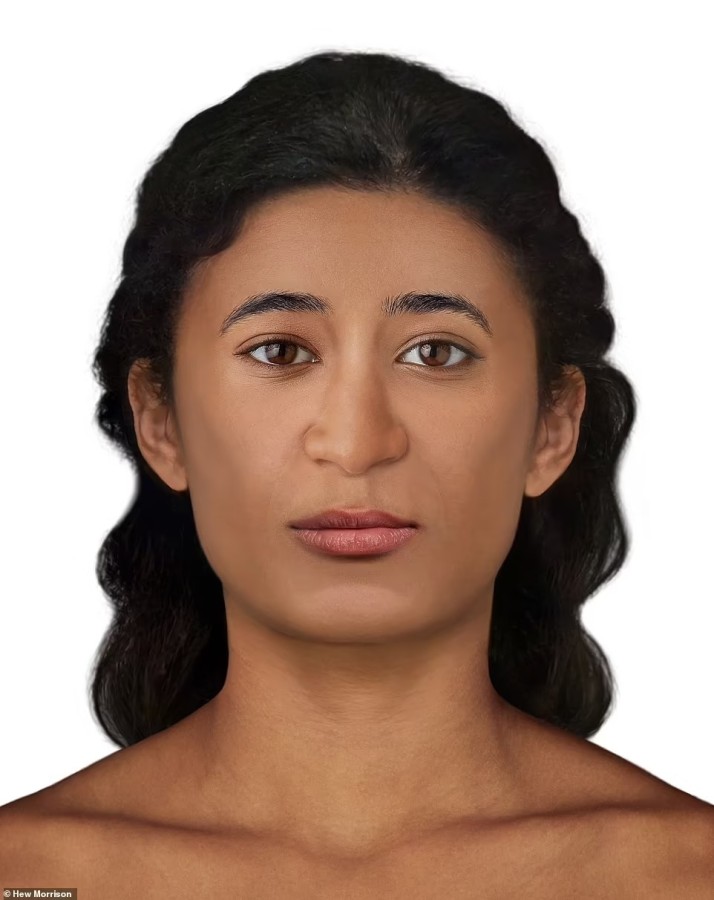
Known as ‘The Mysterious Lady’, the embalmed woman was analysed last year by a team of Polish researchers, who discovered evidence of a foetus inside her.
They believe she died about 2,000 years ago while 28 weeks into her pregnancy, and was most likely aged between 20 and 30.
Now, experts have used her skull and other remains to produce two images showing what she may have looked like when alive in the first century BC.
Chantal Milani, an Italian forensic anthropologist and member of the Warsaw Mummy Project, said: ‘Our bones and the skull in particular, give a lot of information about the face of an individual.
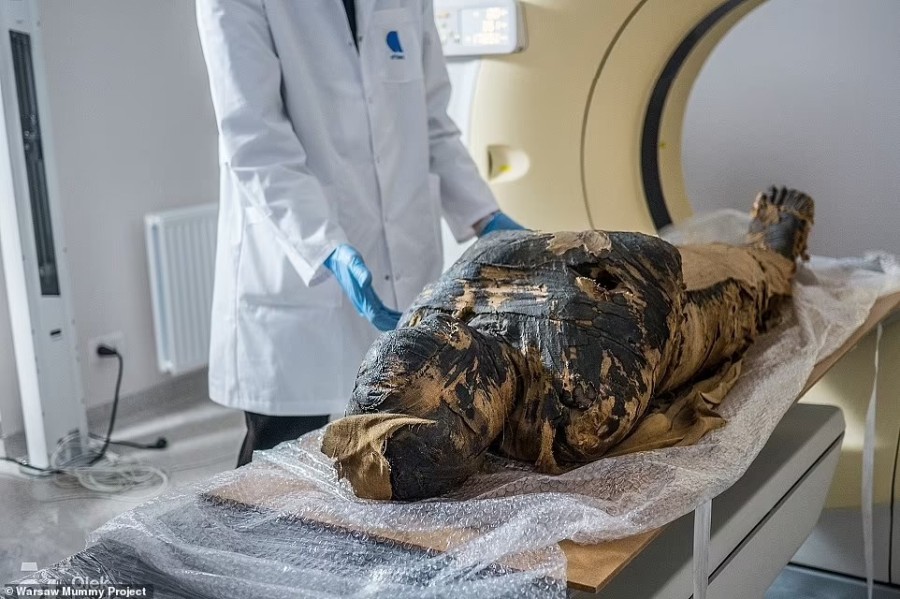
‘Although it cannot be considered an exact portrait, the skull like many anatomical parts is unique and shows a set of shapes and proportions that will appear in the final face.’
Two forensic specialists, alongside researchers from the University of Warsaw, wanted to ‘re-humanise’ the mummy by using both 2D and 3D techniques to reconstruct her face. Pictured: Facial reconstruction of ‘The Mysterious Lady’
Chantal Milani, an Italian forensic anthropologist and member of the Warsaw Mummy Project, said: ‘Although it cannot be considered an exact portrait, the skull like many anatomical parts is unique and shows a set of shapes and proportions that will appear in the final face.’. Pictured: Facial reconstruction of ‘The Mysterious Lady’
Known as ‘The Mysterious Lady’, the embalmed woman was analysed last year by a team of Polish researchers, and X-ray scans and CT images revealed evidence of foetus inside her
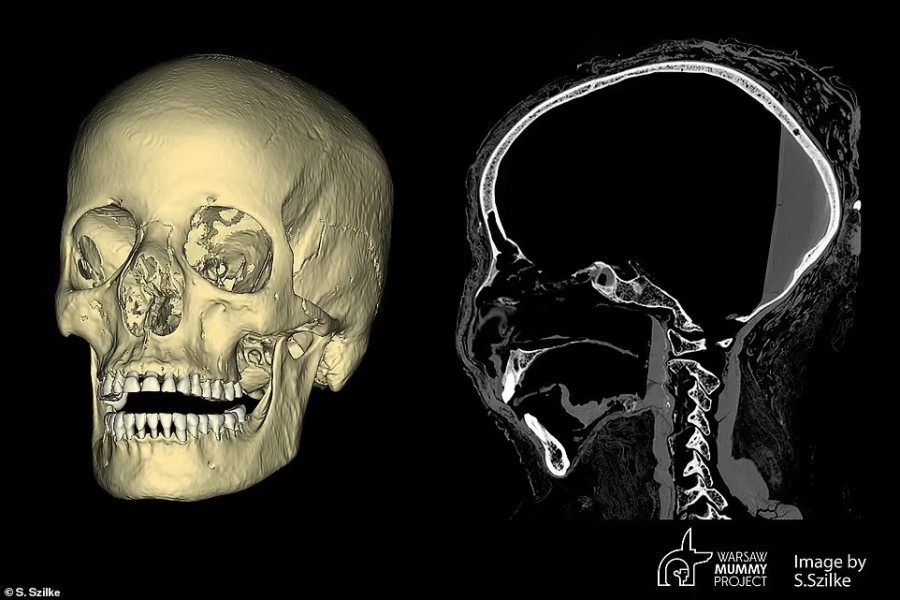
World’s first pregnant ancient Egyptian mummy
Brought to Poland in the mid-19th century, the ‘Mysterious Lady’ represents the first known pregnant ancient Egyptian mummy.
Experts at Warsaw Museum Project discovered that the mummy was pregnant in 2021, and that the foetus had been ‘pickled like a gherkin’.
An examination using tomographic imaging revealed that the woman was between 20-30 years old when she died and was in her 26th to 30th week of her pregnancy.
The mummy was previously thought to be the remains of the priest Hor-Jehuti, until it was discovered in 2016 to be an embalmed woman.
She added: ‘The face that covers the bone structure follows different anatomic rules, thus standard procedures can be applied to reconstruct it, for example to establish the shape of the nose.
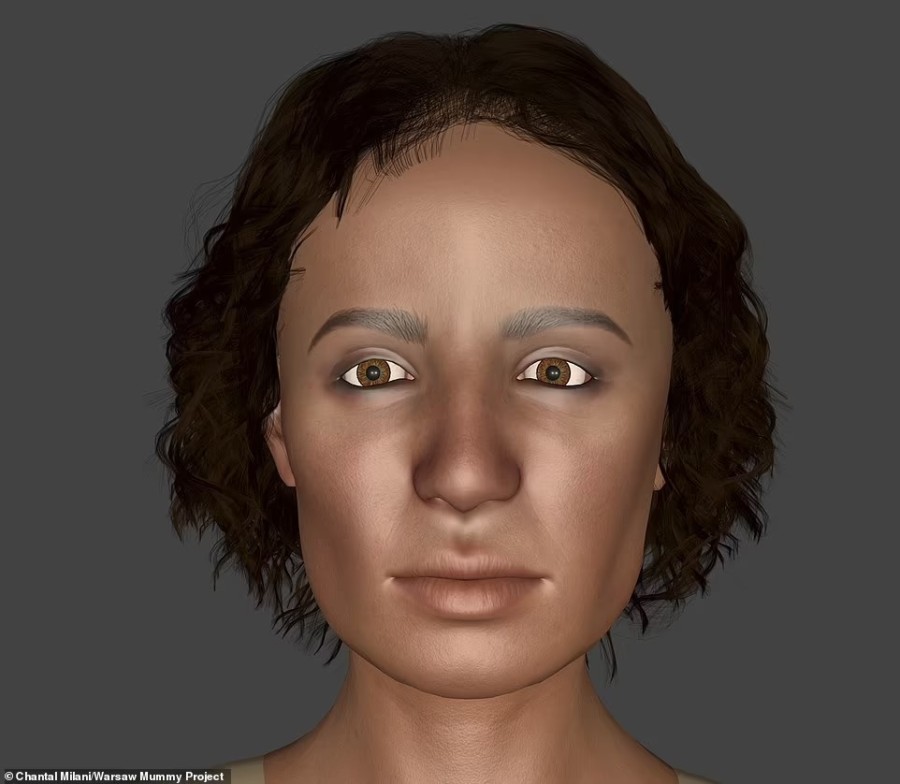
‘The most important element is the reconstruction of the thickness of the soft tissues at numerous points on the surface of the facial bones.
‘For this, we have statistical data for various populations across the globe.’
The Mysterious Lady is said to have been found in royal tombs in Thebes, Upper Egypt, coming from the elite of Theban community.
Her mummy was discovered in the early 1800s and dates back to the first century BC, a time when Cleopatra was Queen and the city of Thebes was a hive of activity.
The mummy was taken out of Egypt and into Warsaw in December 1826, around the time of some of the most important discoveries from the Egyptian Valley of the Kings.
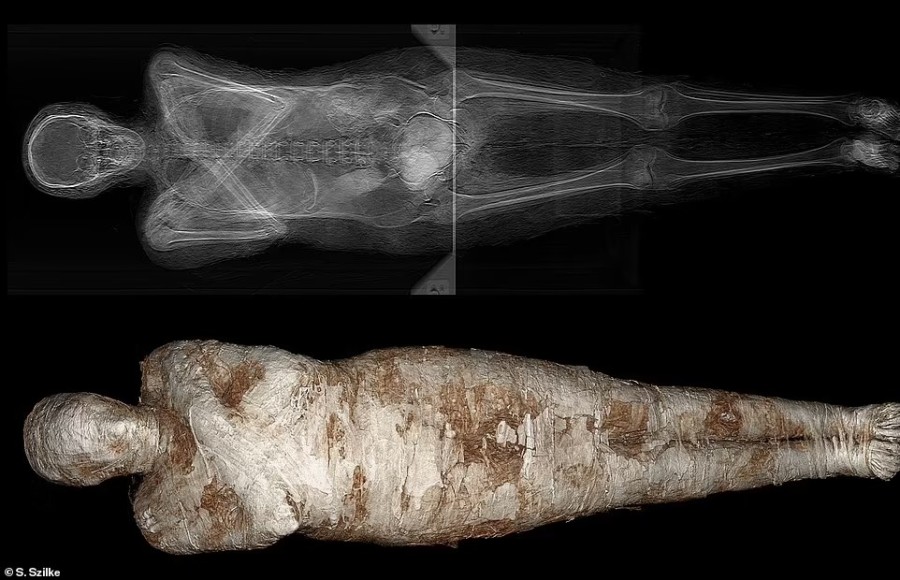
While initially thought to be the remains of the priest Hor-Jehuti, the mummy was discovered in 2016 to be an embalmed woman.
Her body had been carefully wrapped in fabrics and left with a rich set of amulets to see her into the afterlife.
‘Mummification was an expression of the care given to preserve a person for the afterlife,’ wrote the Warsaw Mummy Project on Facebook.
The mummy is believed to be the first embalmed specimen known to contain a foetus, and is currently on show at the National Museum in Warsaw.
Two forensic specialists, alongside researchers from the University of Warsaw, wanted to ‘re-humanise’ the mummy by using both 2D and 3D techniques to reconstruct her face.
Forensic artist Hew Morrison said: ‘Facial reconstruction is mainly used in forensics to help determine the identity of a body when more common means of identification such as fingerprint identification or DNA analysis have drawn a blank.
‘Reconstructing an individual’s face from their skull is often considered as a last resort in an attempt to establish who they were.
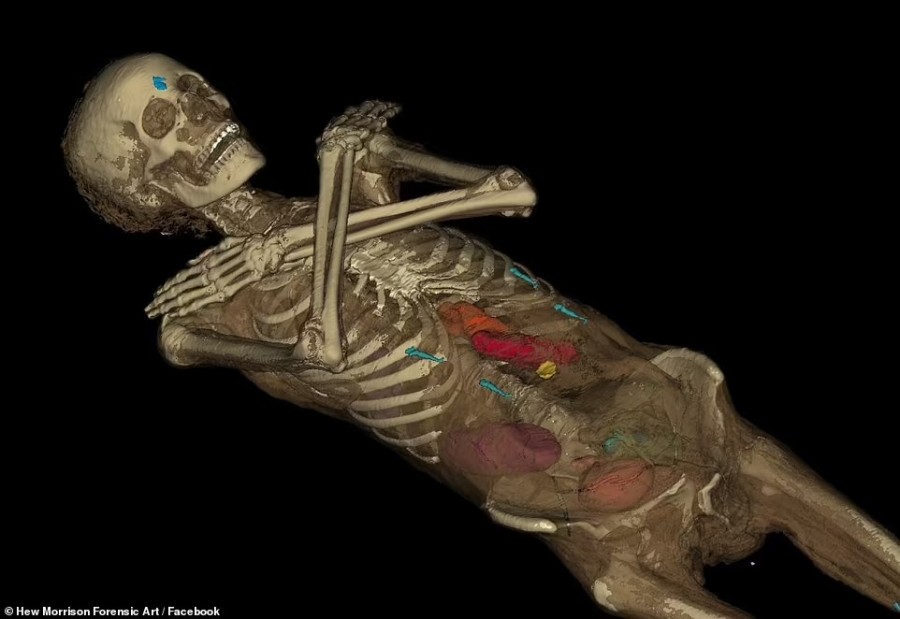
‘It can be also used in an archaeological and historical context to show how ancient people or famous figures from the past would have appeared in life.
‘In a historical context, the process helps to figuratively bring the deceased back to life, thus fostering respect and sensitivity for the deceased who are either the subject of research or are being exhibited in museums.’
Dr Wojciech Ejsmond, an archeologist from the Polish Academy of Sciences, added: ‘For many people, ancient Egyptian mummies are curiosities and some people tend to forget that these were once living people who had their own individual lives, loves, and tragedies.
‘We can say that forensic experts provide faces for the scientific data, so the person is then no longer an anonymous “curiosity in a showcase”.
‘Also, it was very important for ancient Egyptians to preserve one’s likeness to help retain the survival of a soul and identity.
‘So, on one hand, we are, let’s say, “re-humanising” scientific data and on the other fulfilling the desire of these people not to be anonymous and forgotten.’
The facial reconstructions can be seen in an exhibition at the Silesia Museum in Katowice on November 3.
Forensic experts used her skull (pictured) and other remains to produce two images showing what ‘The Mysterious Lady; may have looked like when alive in the first century BC
The mummy was previously thought to be the remains of the priest Hor-Jehuti, until it was discovered in 2016 to be an embalmed woman
An examination using tomographic imaging revealed that the woman was between 20-30 years old when she died and was in her 26th to 30th week of her pregnancy
The foetus, which had been ‘pickled like a gherkin’, was located in the lower part of the lesser pelvis and partly in the lower part of the greater pelvis and was mummified together with its mother.
CT images of the infant were obscured by tissue from the uterus surrounding it, which meant they could not get a more detailed analysis beyond measuring the head.
Its head circumference was 9.8 inches, which the team used to determine it was between the 26th and 30th week of life.
It wasn’t taken out from the uterus, as was in the case of the heart, lungs, liver and intestines with the stomach.
Experts at the Warsaw Mummy Project couldn’t say why the foetus wasn’t extracted and mummified on its own, as has been shown in other instances of stillborn children.
‘It may have been thought to be still an integral part of the body of its mother, since it was not yet born,’ they said at the time.
The foetus hadn’t been given a name, even though, according to ancient Egyptian beliefs, a name was an important part of a human being.
Thus, it’s thought ancient beliefs stipulated the unborn child’s afterlife could only have happened if it had gone to the netherworld as part of its mother.
The foetus was preserved for more than 2,000 years because it was ‘pickled’ like an egg by the acidification of the woman’s body as she decomposed
Experts at the Warsaw Mummy Project couldn’t say why the foetus wasn’t extracted and mummified on its own, as has been shown in other instances of stillborn children
Researchers from the Polish Academy of Sciences published an article in 2021 about how their scans revealed the mummy was pregnant.
However, in August, an extraordinary row broke out among the team, with several members questioning the finding.
They claimed that what appeared to be a foetus in X-ray scans and CT images was actually the result of ‘a computer illusion and misinterpretation’.
Instead of a baby, they believe it is ‘mummified organs’ inside the woman’s stomach.
Kamila Braulińska, a co-founder of the Warsaw Mummy Project, said the original research was ‘not a reliable scientific study’, while radiologist Łukasz Kownacki and conservationist Dorota Ignatowicz-Woźniakowska also dispute the research.
But two members of the project, Marzena Ozarek-Szlike and Wojciech Ejsmond, have dismissed these claims.
They said: ‘The Warsaw Mummy Project team does not confirm this information. The mummy is pregnant.’
Based on the position of the foetus and how the birth canal was closed, the researchers were able to determine that the Mysterious Lady did not die in childbirth.
In July, it was revealed that the mummified woman likely died from nasopharyngeal cancer – a rare type of cancer that affects the part of the throat connecting the back of the nose to the back of the mouth.
The Warsaw Mummy Project researchers were carrying out a scan of the ancient corpse’s skull when they discovered unusual markings in the bone that indicate the cancer.
Researchers at the Warsaw Mummy Project in Poland were carrying out a scan of the ancient corpse’s skull (left) when they discovered unusual markings in the bone (indicated in cross section scan on the right)
The Egyptian mummy (pictured) was discovered in the early 1800s and dates back to the first century BC, a time when Cleopatra was Queen and the city of Thebes was a hive of activity
The mummy is believed to be the first embalmed specimen known to contain a foetus, and is currently on show at the National Museum in Warsaw
These are the earliest drawings of the mummy casing, dating back to the 1800s when the mummy was first taken to Poland
How the foetus preserved within ‘The Mysterious Lady’ was ‘pickled’ by acidification
The foetus was preserved for more than 2,000 years because it was ‘pickled’ like an egg by the acidification of the woman’s body as she decomposed.
Palaeopathologist Marzena Ożarek-Szilke of the University of Warsaw and her colleagues said that blood pH in corpses becomes more acidic over time, including in the uterus, and concentrations of ammonia and formic acid increase.
The body would have been filled with ‘natron’, a mineral salt found in dried lake beds, by the ancient Egyptians as part of the embalming process, which would have limited the access of air and oxygen.
‘The end result is an almost hermetically sealed uterus containing the foetus’, said Dr Ożarek-Szilke. ‘The foetus was in an environment comparable to the one which preserves ancient bodies to our time in swamps.’
This acidification would have demineralised the foetus’ bones, even as its soft tissues were preserved, which explains why they are not visible in the scans.
‘Picture putting an egg into a pot filled with an acid,’ the researchers said. ‘The eggshell dissolves, leaving only the inside of the egg — albumen and yolk — and the minerals from the eggshell dissolved in the acid.’
According to Dr Ożarek-Szilke and her colleagues, foetal bones are very poorly mineralised during the course of the first two trimesters of pregnancy anyway, meaning they are difficult to detect in the first place.
Read more here
Some experts at the Warsaw Mummy Project claimed that what appeared to be a foetus in X-ray scans and CT images was actually ‘a computer illusion and misinterpretation’. They say some of the objects depicted here with arrows were wrongly identified as a foetal head and body. However, two members of the project, Marzena Ozarek-Szlike and Wojciech Ejsmond, have dismissed these claims
Related Post
A shocking documentary proves that mermaids do exist
SHOCKING Revelation: Thuya, Mother of Queen Tiye, Was the Grandmother of Akhenaten and Tutankhamun—What Ancient Egyptian Secrets Did She Leave Behind?
Breaking News: Astonishing Discoveries at Karahan Tepe Confirm an Extraterrestrial Civilization is Hiding on Earth, and NO ONE Knows!
Breaking News: Researchers FINALLY Discover U.S. Navy Flight 19 After 75 Years Lost in the Bermuda Triangle!
NASA’s Secret Investigation: Uncovering the Astonishing Mystery of the UFO Crash on the Mountain!
Explosive UFO Docs LEAKED: Startling Proof That Aliens Ruled Ancient Egypt!